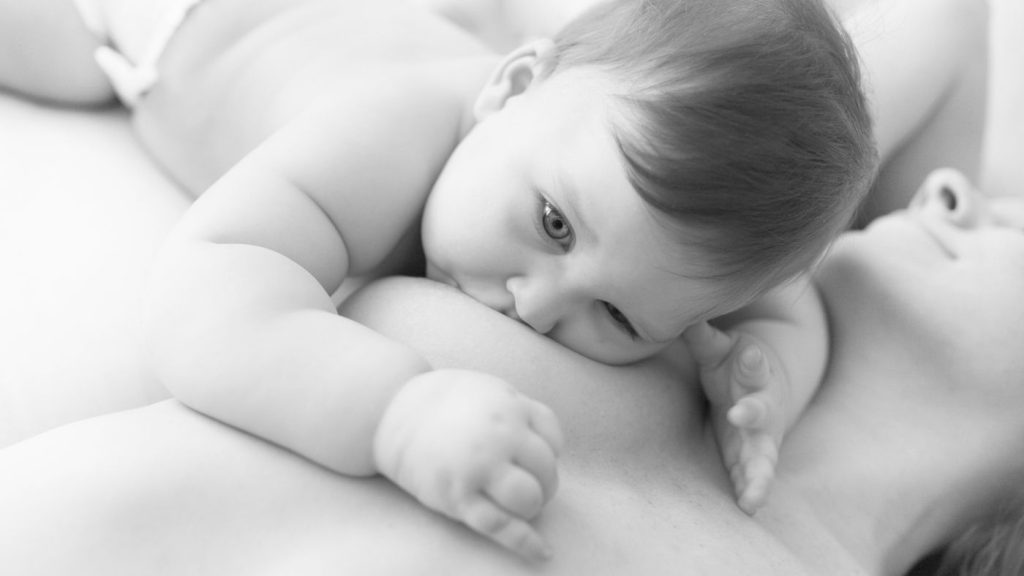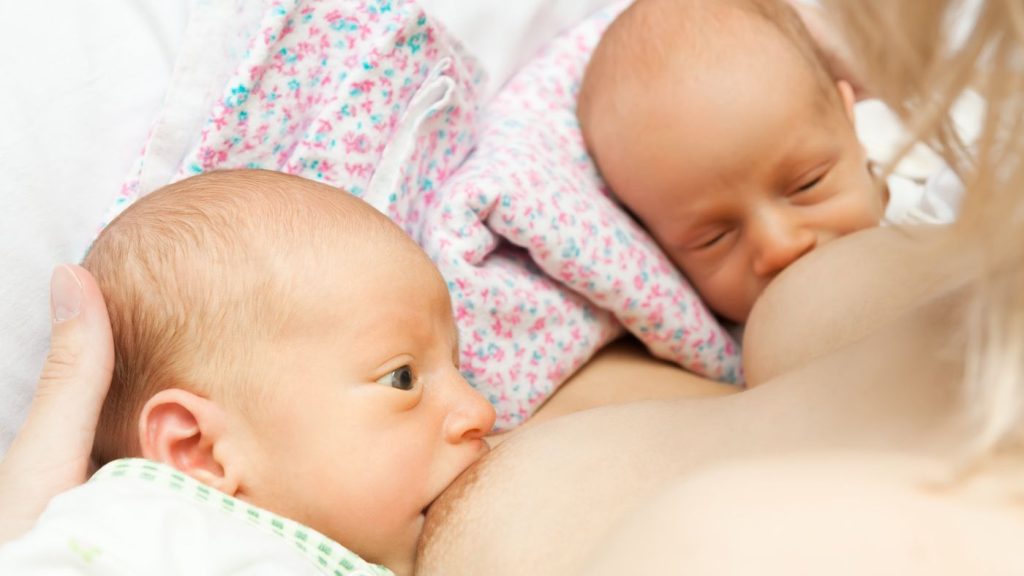There’s no right or wrong way to hold and feed your baby, and each mum and baby will find their own preferred position to feed in. What’s important is that you both feel comfortable.1,2 Knowing a few different breastfeeding positions and techniques can be helpful because life often requires us to be versatile, especially as your baby gets bigger and you start to go out and about more.
Discover 11 different breastfeeding positions and find out what is best for you and your baby:
- Laid-back breastfeeding or reclined position
- Cradle hold
- Cross-cradle hold
- Rugby ball hold
- Side-lying position
- Laid-back breastfeeding after a c-section
- Upright breastfeeding or koala hold
- Dangle feeding
- Nursing in a sling
- Double rugby ball hold
- Dancer hand nursing position
Whichever breastfeeding position you choose, remember:
- Gather everything you need, such as a drink, snacks, your mobile, TV remote, book or magazine, before you start feeding. And don’t forget to have a wee first – you may not be able to get up again for some time!
- Make sure your baby is comfy. Whatever position you’re in, your baby should be stable and supported, while his head, neck and spine should not be twisted.
- Ensure you feel relaxed and comfy too. Use cushions, pillows or rolled towels to support your back or arms if you need to.
- Check your baby is latching on correctly. A good latch is vital for comfortable breastfeeding.
- If your baby struggles to latch or breastfeeding makes you sore, seek support from a lactation consultant or breastfeeding specialist. They will also be able to show you how to support your baby to help you feed more comfortably.
1: Laid-back breastfeeding or reclined position
The laid-back breastfeeding position, also known as biological nurturing,1 is often the first mums try. If your baby is placed on your chest or tummy as soon as he’s born, all being well he’ll instinctively work his way towards one of your breasts and attempt to latch on – this is known as the ‘breast crawl’. Skin-to-skin contact helps stimulate his feeding instincts, while gravity helps him to latch on well and keeps him in place.
However, laid-back breastfeeding isn’t just for newborns – it can work well with babies of any age. It may be especially useful if your baby struggles to latch in other holds, he doesn’t like his head being touched as he feeds, if you have a forceful let down, or if your breasts are large, as mum-of-one Isabel, UK, discovered: “The combination of my big boobs and a small 2.7 kg (6 lb) baby made positioning tricky at first. It took me a few weeks to realise there was no position I ‘should’ be in. In the end I mainly breastfed lying down with my baby balanced on top of me.”
You’ll probably be comfier if you’re reclining gently rather than lying flat on your back. Use cushions or pillows so you’re supported and can see your baby.


2: Cradle hold
This is the classic position most of us picture when we think of breastfeeding. It involves you sitting upright, with your baby positioned on his side, his head and neck laying along your forearm and his body against your stomach, in a tummy-to-mummy position.3 Although it’s a very popular position, it’s not always easy with a newborn because it doesn’t give your baby as much support as some other holds. A pillow or cushion behind you and a breastfeeding pillow across your lap propping up your baby or your arms may give you more support, and avoid strain on your back or shoulders. If you use a breastfeeding pillow, make sure it doesn’t lift your baby too high – your breasts should remain at their natural resting height to avoid sore nipples and a strained latch.
“I used the cradle hold because it worked! It felt comfortable and I liked sitting there just looking at my baby,” says Rachael, mum of two, Italy.


3: Cross-cradle hold
This looks similar to the cradle hold but your arms switch roles so your baby’s body lies along your opposite forearm.3 The aim is to support your baby around his neck and shoulders to allow him to tilt his head prior to latch. This is a great newborn breastfeeding position and is also good for small babies and those with latching difficulties. Because your baby is fully supported on your opposite arm, you have more control over his positioning, and you can use your free hand to shape your breast.
Julie, mum of two, UK, likes the flexibility of this position: “I normally do the cross-cradle with my newborn. It gives me a hand free to tend to my toddler at the same time.”
In the early days, don’t hold your baby around his head as you might push his chin on to his chest. This can result in a shallow latch (as your nipple hits the base of his tongue rather than his palate) and sore nipples for you. As your baby gets bigger this technique becomes much easier, and you can rest your baby’s head in your hand (as shown in our gallery image above).


4: Rugby ball hold
In this position (also known as the underarm or clutch), you sit with your baby resting along your forearm. His body tucks alongside your side, with his feet towards the back of the chair, or whatever you’re sitting on.3 This is another helpful early nursing position because it supports your baby well, while giving you plenty of control and a good view of his face. Being tucked in closely alongside your body will help your baby feel safe too. Mums who’ve had a c-section, twins, or a premature baby, along with those who have larger breasts, may also like this position.
“With my first daughter I had very large K-size breasts that were double the size of her head,” remembers Amy, mum of two, Australia. “I placed a rolled-up towel underneath each breast to help lift them up as they were so heavy, and fed her in a rugby ball hold, but more upright so she wasn’t overwhelmed by their size. This position was also good as I had a c-section wound and couldn’t rest her across my body.”


5: Side-lying position
Ideal for relaxed night feeds and breastfeeding in bed or on the sofa, side-lying can also be more comfortable than sitting if you’ve had a caesarean or stitches.3 You and your baby need to lie on your sides next to one another, belly-to-belly.
“I struggled to sit up in bed during countless night feeds, partly due to having had a c-section, partly due to exhaustion,” says Francesca, mum of one, UK. “Then I discovered I could feed my baby lying on my side and relax at the same time.”
“Maisie couldn’t attach any other way than the side-lying position due to her tongue-tie. A lactation consultant showed me how to do it. It seemed like she could handle the strength of my flow and hold on better in this position. When her mouth grew bigger she became much better at attaching in the regular way,” says Sarah, mum of two, Australia.


6: Laid-back breastfeeding after a c-section
If you’ve had a caesarean delivery and can’t find a comfortable breastfeeding position,3 this may help. Reclining with your baby’s body across your shoulder will let you nurse comfortably without any weight or pressure on your wound, or you could also try side-lying.


7: Upright breastfeeding or koala hold
In the upright or koala hold, your baby sits straddling your thigh, or on your hip, with his spine and head upright as he feeds.4 You can do this hold with a newborn if you give your baby plenty of support, and it’s also a convenient way to feed an older baby who can sit unaided. The upright or koala hold is often the most comfortable breastfeeding position for babies who suffer from reflux or ear infections (who often prefer to be upright), and it can also work well with babies who have a tongue-tie or low muscle tone.
“When my baby was older I often used the upright hold because it was comfortable for both of us and I could still feel her body close to mine,” says Peggy, mum of one, Switzerland. “It was also discreet when we were feeding in public.”


8: Dangle feeding
This breastfeeding position involves your baby lying on his back, while you crouch over him on all fours and dangle your nipple in his mouth.4 Some mums say doing this for short periods helps if they have conditions like mastitis and don’t want their breasts to be squashed or touched; others claim that gravity helps unplug blocked milk ducts, although there’s no scientific evidence to support this yet. You can also dangle feed while you’re sitting, kneeling up over your baby on a bed or sofa, or almost lying down but propped up on your arms. You may need to use cushions and pillows to support yourself so you don’t strain your back or shoulders.
“I used the dangle feeding position a few times when I had blocked ducts and other methods of easing out the lumps in my breasts hadn’t worked. It seemed to help – I think because gravity was in my favour, and because the angle and position of my baby were so different to our normal breastfeeds that she drained my breast differently,” says Ellie, mum of two, UK.
Dangle feeding is probably not a breastfeeding position you want to do regularly, but it might just help if you need to mix it up.
“I used a dangle feeding position when my baby was struggling to latch,” says Lorna, mum of two, UK. “It wasn’t the most comfortable way to breastfeed, but at the time I’d do absolutely anything to get him to latch. It worked – and we’re still breastfeeding eight months on!”


9: Nursing in a sling
It may take a little practice, but breastfeeding your baby in a sling can be convenient when you’re out and about, looking after older children, or even doing light chores.
It’s also handy if your baby dislikes being put down or feeds frequently, as Lindsay, mum of two, US, found: “I used a front carrier often with both my babies. When we were out I tied a sarong around my neck and draped it over the carrier so it worked as a cover. They would nurse like this until they fell asleep.”
This method usually works best if your baby is an experienced breastfeeder and can hold his head up by himself.You can breastfeed in all sorts of slings, including stretchy wraps, ring slings and front carriers. Whichever you choose, make sure you can always see your baby’s face and his chin is not pressed against his chest.


10: Double rugby ball hold
The double rugby ball hold (also known as the double clutch) is a great breastfeeding position for twins, as you can feed them in tandem while having your hands relatively free.4 You’ll probably need to use a specially designed twin breastfeeding pillow while feeding like this, especially in the early days. This gives extra support to get both babies into position, and also minimises pressure on your belly if you’ve had a c-section. You may also find that with your hands freer, you can tend to one baby without disrupting the other’s feed.
“When my twins were born they were tiny and needed feeding every two hours, day and night. I soon realised for me to achieve anything other than feeding, I needed to tandem feed,” says Emma, mum of two, UK. “I used the double rugby ball hold with a breastfeeding cushion.”
Other breastfeeding positions you could try with twins include two cradles crossed across one another, one twin in a rugby ball hold and one in a cradle hold, and double laid-back or double upright breastfeeding positions.


11: Dancer hand nursing position
If your baby struggles to stay latched on or has low muscle tone – perhaps because he was born prematurely, has a condition such as Down’s syndrome, or has an illness or disability – try this hold to support both his head and your breast.4 Start by cupping your breast with your hand underneath, fingers on one side and thumb on the other. Then edge your hand forwards so your thumb and index finger form a ‘U’ shape just in front of the breast. Your three remaining fingers should continue to support the breast underneath. Rest your baby’s jaw on your thumb and index finger as he feeds, with his chin at the bottom of the ‘U’, your thumb gently holding one of his cheeks and your index finger the other. This hold gives your baby plenty of support and you control over his position, as well as a great view of his latch.

1 Colson SD et al. Optimal positions for the release of primitive neonatal reflexes stimulating breastfeeding. Early Hum Dev. 2008;84(7):441-449.
2 UNICEF UK BFHI [Internet]. Off to the best start ; 2015 [cited 2018 Feb].
3 Cadwell K. Latching‐On and Suckling of the Healthy Term Neonate: Breastfeeding Assessment. J Midwifery & Women’s Health. 2007;52(6):638-642.
4 Wambach K, Riordan J, editors. Breastfeeding and human lactation. Jones & Bartlett Learning; 2014. 966 p.























